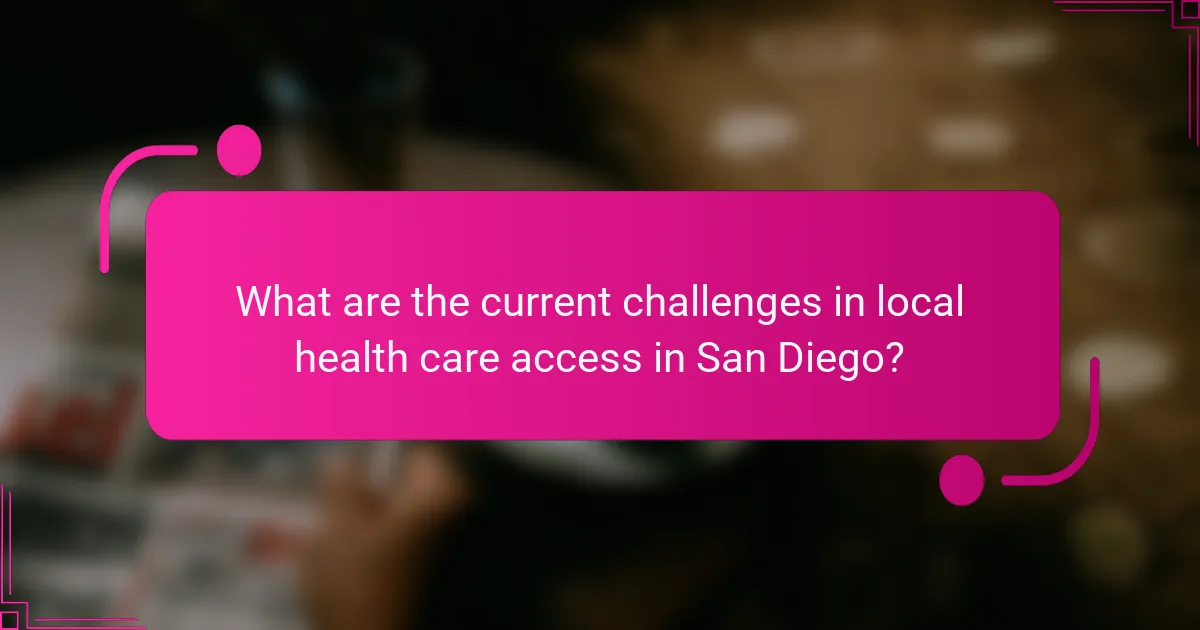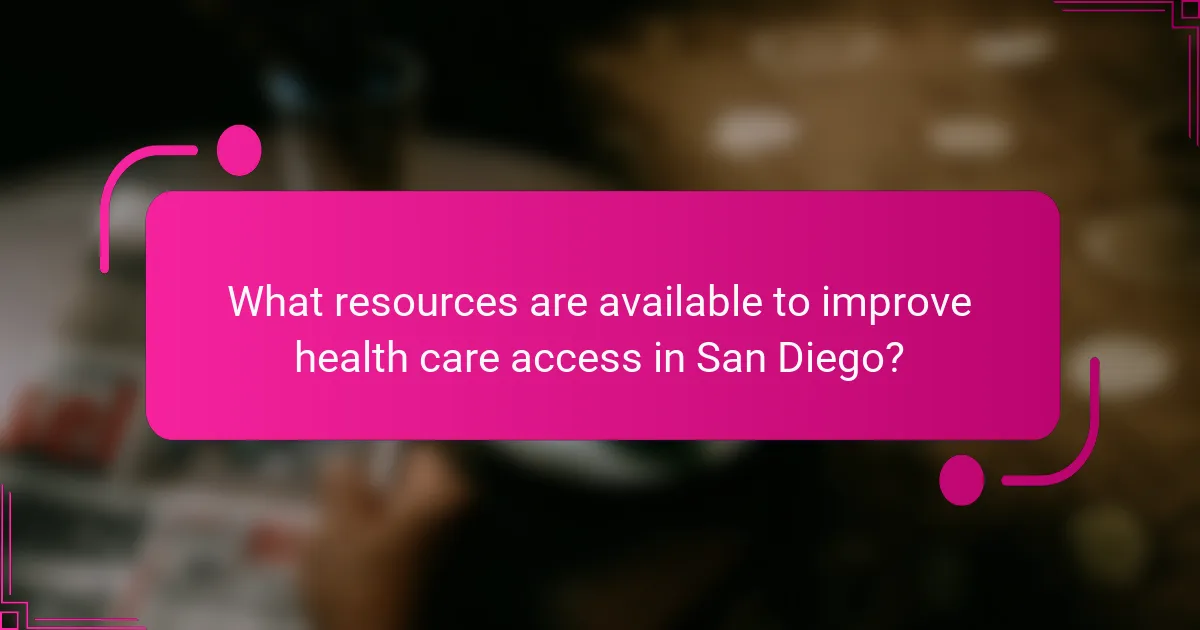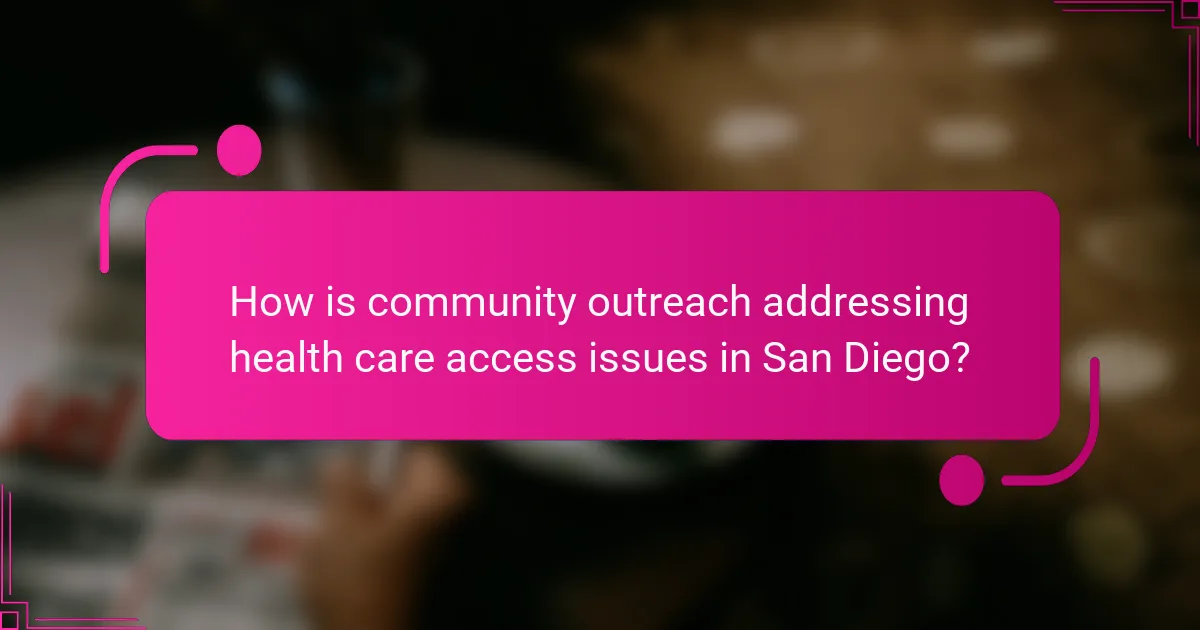
What are the current challenges in local health care access in San Diego?
Current challenges in local health care access in San Diego include high costs, limited insurance coverage, and provider shortages. Many residents face financial barriers that prevent them from seeking necessary care. Additionally, a significant portion of the population is uninsured or underinsured. This limits their access to essential services. Long wait times for appointments exacerbate the issue, creating delays in receiving care. Language barriers also hinder access for non-English speakers. Geographic disparities exist, with underserved areas lacking sufficient health facilities. These factors collectively contribute to challenges in health care access in San Diego.
How do socioeconomic factors influence health care access in San Diego?
Socioeconomic factors significantly influence health care access in San Diego. Individuals with lower income levels often face financial barriers to obtaining health care. Limited insurance coverage is prevalent among low-income populations. This lack of coverage restricts access to necessary medical services. Additionally, education level affects health literacy, impacting individuals’ ability to navigate the health care system. Neighborhoods with higher poverty rates typically have fewer health care facilities. Geographic location also plays a role, with underserved areas lacking adequate transportation options. Studies indicate that these socioeconomic factors contribute to health disparities within the community.
What specific demographics are most affected by these socioeconomic barriers?
Low-income families are the specific demographics most affected by socioeconomic barriers in San Diego. These families often lack access to quality health care services. Individuals from minority ethnic backgrounds also face significant challenges. They experience higher rates of chronic illnesses and lower health outcomes. According to the San Diego County Health and Human Services Agency, 25% of Hispanic residents report unmet health care needs. Additionally, uninsured rates are higher among low-income and minority populations. This demographic often struggles with transportation and language barriers, further complicating access to care.
How do income levels correlate with health care access in the region?
Income levels significantly correlate with health care access in the region. Higher income levels typically lead to better access to health care services. Individuals with higher incomes can afford insurance premiums and out-of-pocket expenses. This financial capability allows them to seek preventive care and timely treatments. Conversely, lower-income individuals often face barriers to accessing health care. They may lack insurance or be underinsured, limiting their access to necessary services. According to a study by the Kaiser Family Foundation, uninsured individuals are less likely to receive regular medical care. This disparity highlights the impact of income on health care access in the region.
What geographical barriers exist that impact health care access in San Diego?
Geographical barriers that impact health care access in San Diego include urban sprawl and socioeconomic disparities. Urban sprawl leads to longer travel distances for residents to reach health care facilities. Many low-income neighborhoods are located far from hospitals and clinics. This situation is exacerbated by limited public transportation options. Additionally, certain areas have fewer health care providers, creating a shortage of available services. The geographic layout often isolates vulnerable populations, making access more challenging. These factors collectively hinder timely health care access for many residents in San Diego.
How does transportation availability affect access to health care facilities?
Transportation availability significantly affects access to health care facilities. Limited transportation options can lead to delays in receiving medical care. A study by the American Hospital Association found that 3.6 million people in the U.S. miss medical appointments due to transportation issues. This lack of access can exacerbate health conditions and increase emergency room visits. Conversely, reliable transportation improves timely access to preventive care and routine check-ups. In San Diego, public transit services play a crucial role in connecting residents to health services. Areas with better transportation infrastructure report higher rates of health care utilization. Thus, transportation availability is a critical factor in ensuring equitable access to health care.
What areas in San Diego are considered health care deserts?
Certain areas in San Diego are identified as health care deserts. These include neighborhoods such as Southeastern San Diego, which encompasses communities like Encanto and Skyline. Additionally, parts of City Heights face significant barriers to health care access. The lack of medical facilities and providers in these regions contributes to their designation as health care deserts. According to a 2021 report by the San Diego County Health and Human Services Agency, these areas have limited access to essential health services, affecting residents’ overall health outcomes.

What resources are available to improve health care access in San Diego?
San Diego offers various resources to improve health care access. Community clinics provide low-cost services to uninsured individuals. Programs like Medi-Cal expand coverage for low-income residents. The San Diego County Health and Human Services Agency coordinates public health efforts. Telehealth services enhance access, especially for remote areas. Nonprofit organizations offer assistance with health navigation and education. Mobile health units reach underserved populations directly. Local hospitals often have outreach programs to support community health initiatives. These resources collectively aim to reduce barriers to health care access in the region.
What types of community health services are offered in San Diego?
San Diego offers a variety of community health services. These include primary care, mental health services, and preventive care programs. Community clinics provide accessible medical services regardless of insurance status. Mental health services address issues such as depression and anxiety. Preventive care programs focus on vaccinations and health screenings. Additionally, substance abuse treatment services are available for those in need. Maternal and child health services support families during pregnancy and early childhood. Health education programs promote wellness and disease prevention in the community. These services aim to improve overall health outcomes in San Diego.
How do local clinics provide affordable care to underserved populations?
Local clinics provide affordable care to underserved populations by offering sliding scale fees based on income. This allows patients to pay what they can afford, making healthcare accessible. Clinics often receive funding from government programs and grants to subsidize costs. Many local clinics also provide preventive services at low or no cost. This includes vaccinations and screenings, which help in early detection and management of health issues. Additionally, clinics may partner with community organizations to reach those in need. These collaborations enhance outreach and education about available services. By focusing on affordability and accessibility, local clinics play a crucial role in supporting underserved populations.
What role do non-profit organizations play in health care access?
Non-profit organizations play a crucial role in health care access by providing services to underserved populations. They often fill gaps in the health care system where for-profit entities may not operate. These organizations offer free or low-cost medical services, including preventive care and treatment. They also engage in community outreach programs to raise awareness about available health services. In San Diego, non-profits address barriers such as transportation, language, and financial constraints. According to the California Health Care Foundation, non-profits have been instrumental in increasing access to care for low-income individuals. Their efforts improve health outcomes and reduce disparities in health care access.
How can telehealth services enhance health care access in San Diego?
Telehealth services can enhance health care access in San Diego by providing remote consultations and reducing travel barriers. Patients can connect with healthcare providers from their homes, which is especially beneficial for those with mobility issues. Telehealth also allows for quicker appointment scheduling, decreasing wait times for patients. According to a study by the California Health Care Foundation, telehealth usage increased by 50% during the COVID-19 pandemic, demonstrating its effectiveness in improving access. Additionally, telehealth can reach underserved populations in rural areas of San Diego, where medical facilities may be limited. This service can also facilitate follow-up care, ensuring patients remain engaged in their health management.
What are the benefits of telehealth for patients in remote areas?
Telehealth provides significant benefits for patients in remote areas. It improves access to healthcare services, allowing patients to consult with providers without traveling long distances. This convenience reduces travel time and costs, which can be burdensome for individuals in isolated locations. Telehealth facilitates timely medical consultations, enabling quicker diagnosis and treatment. It also enhances continuity of care by allowing patients to follow up with healthcare providers easily. Studies show that telehealth can improve patient satisfaction and health outcomes, particularly for chronic conditions. Furthermore, it increases access to specialists who may not be available locally, offering a broader range of healthcare options.
How has the adoption of telehealth changed during the COVID-19 pandemic?
The adoption of telehealth significantly increased during the COVID-19 pandemic. Prior to the pandemic, telehealth usage was limited. In March 2020, telehealth visits surged by over 154% compared to the same period in 2019. This shift was driven by the need for remote healthcare access amid social distancing measures. Many healthcare providers rapidly implemented telehealth services to continue patient care. Insurance companies expanded coverage for telehealth services during this time. Patients embraced telehealth for its convenience and safety. Studies indicate that patient satisfaction with telehealth services remained high throughout the pandemic. The trend of telehealth adoption is expected to continue post-pandemic.

How is community outreach addressing health care access issues in San Diego?
Community outreach in San Diego is improving health care access by connecting underserved populations with essential services. Initiatives include mobile clinics that deliver care directly to communities. These clinics address barriers such as transportation and cost. Health education programs increase awareness of available resources. Collaborations with local organizations enhance outreach efforts. Data shows that these programs have increased patient engagement in preventive care. Community health workers play a vital role in building trust and facilitating access. Overall, outreach efforts are critical in reducing disparities in health care access across the region.
What initiatives are being implemented to raise awareness about health care resources?
Various initiatives are being implemented to raise awareness about health care resources in San Diego. Community health fairs are organized to provide information and free screenings. Local organizations are distributing educational materials in multiple languages. Social media campaigns are launched to reach a broader audience. Partnerships with schools promote health literacy among students. Workshops and seminars are held to educate residents about available services. Outreach programs target underserved populations to ensure equitable access. These efforts collectively aim to enhance community knowledge of health care resources.
How do community health fairs contribute to improving health care access?
Community health fairs improve health care access by providing free or low-cost services to underserved populations. They offer preventive screenings, vaccinations, and health education in a convenient, accessible location. These events often target communities with limited access to traditional health care facilities. By bringing health resources directly to neighborhoods, health fairs reduce transportation barriers. They also foster connections between community members and local health providers. This can lead to increased utilization of health services. A study by the American Public Health Association found that health fairs significantly increase awareness of available health resources. They also help to identify health disparities within communities.
What partnerships exist between local organizations and health care providers?
Partnerships between local organizations and health care providers in San Diego include collaborations for community health initiatives. These partnerships often focus on improving access to services for underserved populations. Examples include local nonprofits working with hospitals to provide preventive care programs. Health care providers may partner with schools to promote health education. Additionally, community organizations often assist in outreach efforts for vaccination clinics. These collaborations aim to address health disparities in the region. Research indicates that such partnerships enhance health outcomes and increase service utilization.
What strategies can individuals employ to navigate health care access challenges?
Individuals can navigate health care access challenges by utilizing several effective strategies. First, they should research local health care resources, including clinics and community health centers. These facilities often provide services on a sliding scale based on income. Second, individuals can leverage telehealth services, which can increase access to care without the need for travel. Third, obtaining health insurance through state programs or the marketplace can significantly enhance access to necessary services. Fourth, individuals should engage with local advocacy groups that provide assistance and information about navigating the health care system. Additionally, building a support network with family and friends can help in sharing resources and information. Lastly, staying informed about local health policies and community health initiatives can empower individuals to advocate for their health care needs effectively. These strategies are supported by initiatives aimed at improving health care access in underserved communities, such as those documented in the “Health Care Access Barriers in San Diego” report by the San Diego Health and Human Services Agency.
How can residents advocate for better health care services in their communities?
Residents can advocate for better health care services by organizing community meetings. These gatherings allow residents to voice concerns and share experiences. Forming coalitions with local organizations strengthens their advocacy efforts. Utilizing social media platforms can amplify their message and reach a wider audience. Engaging with local government officials is essential for influencing policy changes. Residents can also participate in public health forums to discuss specific health care issues. Collecting data on community health needs provides evidence for their advocacy. Collaborating with health care providers can ensure that community voices are heard in service planning.
What resources are available for individuals seeking assistance with health care access?
Individuals seeking assistance with health care access can utilize various resources. These include local health clinics that offer sliding scale fees based on income. Community health centers provide comprehensive services regardless of insurance status. Nonprofit organizations often assist with navigating health care systems and provide financial aid. State and federal programs like Medicaid and Medicare offer coverage for eligible individuals. Local government health departments provide information on available services and programs. Online platforms also exist for finding providers and resources. These resources collectively enhance access to necessary health care services in San Diego.
Local Health Care Access in San Diego is characterized by significant barriers, including high costs, limited insurance coverage, provider shortages, and geographic disparities. Socioeconomic factors, particularly income and education levels, heavily influence access to care, with low-income families and minority populations facing the most challenges. The article outlines specific demographics affected by these barriers, discusses the role of transportation and telehealth services in improving access, and highlights community outreach initiatives aimed at connecting underserved populations with essential health resources. Additionally, it examines available resources, including local clinics and nonprofit organizations, that strive to enhance health care access in the region.